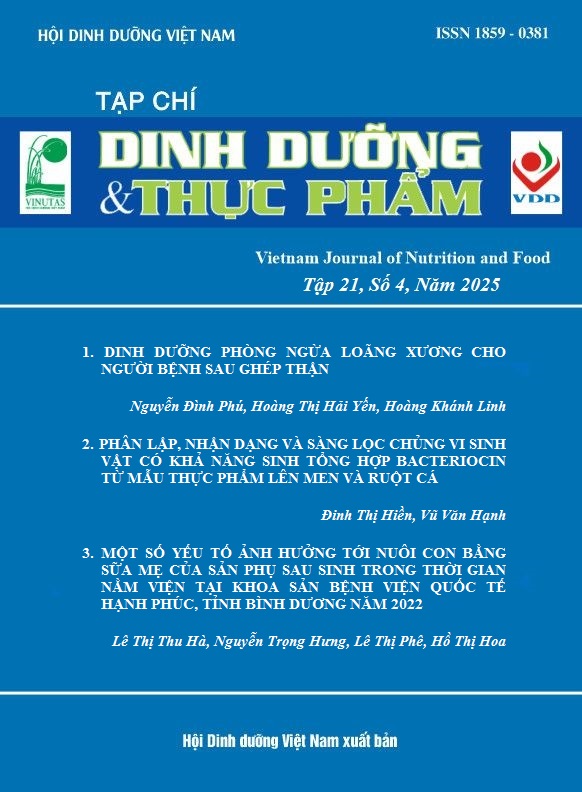HUMAN RESOURCE ASSESSMENT FOR NUTRITION ACTIVITIES ACROSS VIETNAM'S 63 PROVINCES AND CITIES, 2025
Main Article Content
Abstract
Aims: This study aims to assess the current status of the quantity, quality, and distribution of the nutrition workforce at the Centers for Disease Control, District Health Centers, and Commune Health Stations across all 63 provinces/cities in Vietnam. Based on the findings, it seeks to project human resource needs for the next 5–10 years and propose policy and training solutions to meet national health objectives, particularly those set out in the National Nutrition Strategy for the period 2021–2030.
Methods: A cross-sectional study was conducted, targeting nutrition focal staff at the Centers for Disease Control, District Health Centers, and Commune Health Stations across provincial, district, and commune levels in all 63 provinces/cities. Data were collected online using a structured questionnaire and analyzed using Epidata, Stata, and Excel software.
Results: Although the number of nutrition personnel has increased, significant challenges remain regarding workforce quality and distribution. The proportion of staff with university or postgraduate qualifications decreases progressively from the provincial level (80%) to the district (65%) and commune levels (26%). The percentage of personnel holding a bachelor's or master's degree specifically in nutrition is very low—4.5% at the provincial level, 1% at the district level, and only 0.1% at the commune level. A high proportion of staff, particularly at the commune level (61%), have never received formal nutrition training.
Conclusion: Nutrition human resources in Vietnam remain limited in quality and unevenly distributed, particularly at the grassroots level. The study provides a foundation for developing a comprehensive strategy tailored to each level of the health system, prioritizing disadvantaged areas and drawing on international experience. Incorporating qualitative analysis in future research will help strengthen the evidence base for more effective policy planning.
Keywords
Nutrition workforce, human resource distribution, professional training, National Nutrition Strategy, double burden of malnutrition, public health
Article Details
References
2. Bộ Y tế. Thông tư số 08/2013/TT-BYT hướng dẫn thực hiện công tác dinh dưỡng tại các cơ sở y tế. Hà Nội, 2013.
3. Bộ Y tế. Thông tư số 41/2011/TT-BYT về Hướng dẫn cấp chứng chỉ hành nghề y tế. Hà Nội, 2011.
4. Bộ Y tế. Quyết định số 1557/QĐ-BYT về Kế hoạch phát triển nhân lực y tế giai đoạn 2021–2030. Hà Nội, 2021.
5. Nguyễn Thùy Linh, Lê Thị Hương, Ma Ngọc Yến. Thực trạng sử dụng và nhu cầu nhân lực cử nhân dinh dưỡng Việt Nam năm 2020. Tạp chí Nghiên cứu Y học. 2021;146(10):1–10.
6. Trần Bá Kiên. Tổng quan về nghề quản lý, huấn luyện sức khỏe: Thực trạng, thách thức và triển vọng. Vietnam Journal of Community Medicine, 2025, 66(Special Issue 5), 252–256.
7. Nguyen TT, Hoang MV. Food consumption patterns and associated factors among Vietnamese women of reproductive age. Nutrition Journal, 2013, 12, 126. DOI: 10.1186/1475-2891-12-126
8. Feng Y, Tran DT, Shi J, et al. Progress towards health equity in Vietnam: evidence from nationwide official health statistics, 2010–2020. BMJ Global Health. 2024:9(3): e014739.
9. Aluttis C, Bishaw T, Frank MW. The workforce for health in a globalized context -global shortages and international migration. Global Health Action, 2014, 7:23611.


